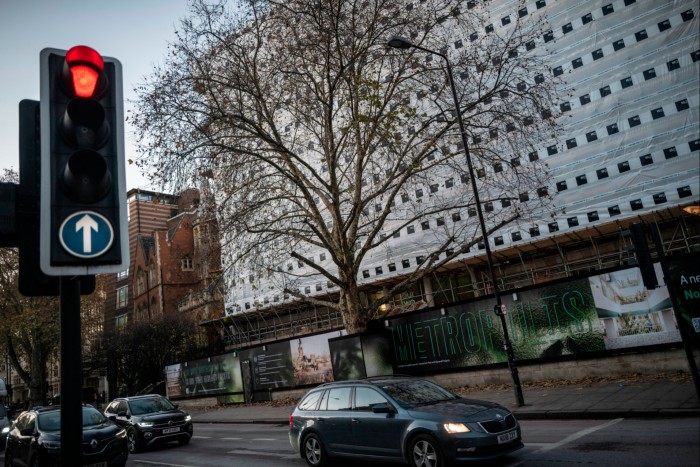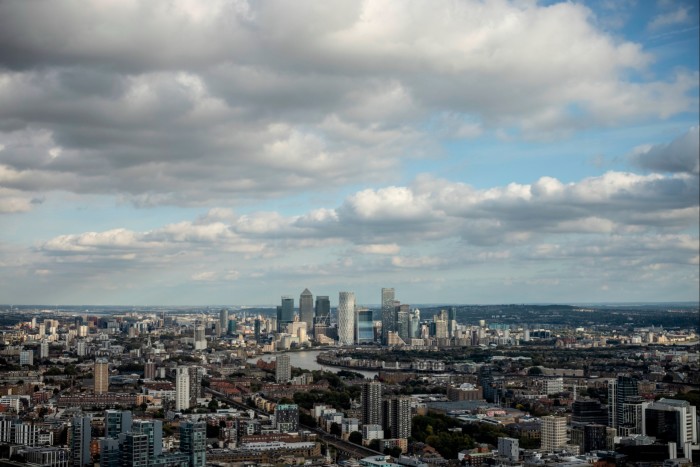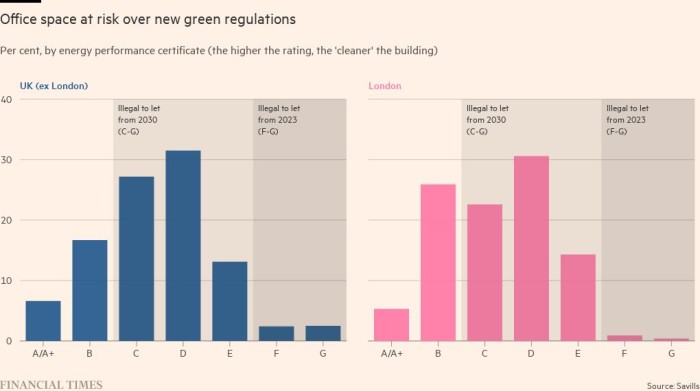When FW Woolworth appointed Richard Seifert to design its new London headquarters, both retailer and architect were on the path to pre-eminence. Woolworths opened its 1,000th UK store soon after construction on the Marylebone block started in 1957; Seifert went on to design Centre Point, one of London’s first skyscrapers.
Since then, Woolworths has gone under, victim to the rise of online shopping and the financial crisis, which together have deprived British high streets of some of their most iconic brands. The Marylebone building Seifert conceived is undergoing an extensive renovation at the hands of developer General Projects and investor Henderson Park. The new owners hope to stop the building slipping, like its former occupier, into obsolescence.
The challenge in central London is replicated in Berlin, New York, Edinburgh and everywhere between. Buildings account for 39 per cent of global energy-related carbon emissions, according to the World Green Building Council, an industry group. Roughly three-quarters of that comes from running them; the remainder from the construction process.
But new environmental regulations to tackle the problem are kicking in at the worst possible time for an industry still reeling from the impact of the pandemic. Companies were already having to think about jettisoning space which homeworking has left surplus to requirements; now the new rules will be phased in as economies tip into recession.
That will put acres of office space worth hundreds of billions around the world at risk of redundancy, say market analysts.
According to estate agency Savills, three-quarters of the UK office market falls below minimum energy efficiency standards which are set to be in place by 2030. A third of Italian offices and a quarter of those in Ireland face the same problem.
In New York, researchers at Columbia and New York University estimate $500bn in office value could be destroyed by 2029 as demand falls and green standards kick in.
Savills estimates the cost of upgrading a building from today’s standards to 2030 requirements to be roughly £40 per sq ft, on top of normal refurbishment costs. Leading landlords in the West End or City of London, charging as much as £100 per sq ft, might be able to absorb the cost. But for owners of buildings in smaller towns, charging more like £20 per sq ft, bearing that cost is impossible.
“There are going to be tonnes of stranded assets, let’s be honest,” says Jacob Loftus, founder and chief executive of General Projects, which specialises in green refurbishments. “Even for those owners which would like to improve [their buildings] there are vast numbers of buildings where it just won’t make sense.”

Over the past few years, landlords have maintained that hitting climate change targets is their biggest concern — a conviction that was not swayed even as the pandemic raged, war broke out in Europe and the global economy clouded over.
Once spun by ethical or image-conscious landlords as the “right” thing to do, upgrading dirty old buildings is increasingly the only option, both legally and commercially. The question is: can they do enough to prevent a plague of zombie offices?
Carbon comes to the fore
Creating a green building is hard, even for those developers who are starting from scratch and using modern techniques and materials.
In Copenhagen, investor and developer Nordic Real Estate Partners is piecing together a new neighbourhood that aims to set a benchmark for environmental performance. In one of the most ambitious pledges across the sector, the company has committed to being net zero by 2028, without making use of the carbon offsets that feature in the plans of many other companies.

In a modern office overlooking the city’s North Harbour, NREP’s head of sustainability Elisabeth Frederiksen acknowledges that such high aspirations come with a price: “The cost is in understanding the complexity. We spend more in the design phase to get it right . . . we really need to roll up our sleeves and do this ourselves.”
At NREP’s new development in Ørestad, Morten Erfurt Hansen, a project manager at contractor CG Jensen, is responsible for delivering UN17, a technically complex building that aims to hit all 17 of the UN’s sustainable development goals.
Standing at the edge of the new neighbourhood, rimmed by a vast green expanse, Erfurt Hansen points to the building site from which UN17 will emerge and bemoans the challenges of building for a net zero pioneer: “You can say, ‘It’s a very good business case, it gets a lot of crosses on the sustainability card’, but it’s extremely hard to carry out in real life.”

Frederiksen is clear that action, however complex, must be taken today. “A [net zero] target of 2050 gives us probably 20 years of doing nothing and then five more of thinking, ‘Oh my god,’” she says. She also criticises others in the sector who pay lip service to lowering emissions but give little time to actually doing it, accusing them of “greenwashing from lack of knowledge, lack of care and lack of intent”.
But Ørestad is proof that sustainable construction is hard even with a clean slate and deep pockets. Most property owners and investors have neither: four in five buildings standing today are expected to still be in place by 2050, and the pressing challenge is how to breathe new life into them before then.
Blocks owned by well-off investors are the tip of a multitrillion-pound iceberg, beneath which is a mass of older, out-of-the-way commercial buildings that would cost more to fix up than they could ever command in rental income. Those blocks risk becoming stranded without urgent intervention.
That is now being forced by tighter regulation. In the UK, buildings receive an energy performance certificate, or EPC, with a top grade of A and a bottom of G. Ministers intend to ratchet up minimum energy efficiency standards (MEES), making it illegal to let out offices with an F or G rating from April next year. Estate agents estimate that will leave 5-10 per cent of UK offices high and dry.

The minimum standard is set to rise to a C rating by 2027 and to a B by 2030, a level which around 70 per cent of offices in the capital fall short of, according to Savills.
In the US, regulations differ state to state and city to city, but commercial property landlords face similar pressures to their peers in the UK. Minimum energy performance standards are also being gradually raised in Europe as the European Commission looks to fully decarbonise building stock by 2050.
With regulations tightening over the next decade, landlords may be tempted to upgrade offices incrementally. But that is difficult, because occupiers moving in for 10 years or more need tomorrow’s buildings today.
“A lot of people are looking at MEES regulations in 2030 and thinking, ‘That’s eight years off.’ But if you are a tenant taking a long-term lease now you wouldn’t be able to sublease it [in the future] if it’s not at MEES 2030 requirements. Positive change is being forced now by that,” says Loftus.
Demand from corporate tenants and wealthy investors for the best space is incentivising developers to go further. There is a constellation of private accreditations, each claiming to prove a building is green. Tenants who have drawn up their own carbon reduction plans are increasingly shunning older blocks and zeroing in on offices wearing those badges of honour.
Buildings with the highest levels of green accreditation make up less than 10 per cent of the London market, but account for around 60 per cent of all space leased in London this year, according to Savills.
But Julie Hirigoyen, chief executive of the UK Green Building Council, suggests prospective tenants should be cautious. “There are a lot of metrics flying around, none of which have been wholeheartedly endorsed by the industry as the threshold needed to claim a credible net zero status,” she says.
Her organisation is working with various other sector bodies on a unified “net zero carbon buildings verification standard” that captures the full impact of constructing and operating an office. Hirigoyen claims that could be a game changer for property owners looking to go green.
“Until this standard has emerged, we don’t really know what we’re targeting,” she says.
A huge bill
Ultimately, tougher regulations will “cut emissions, tackle energy poverty, reduce people’s vulnerability to energy prices and support the economic recovery and job creation”, according to the European Commission. But they also come with a colossal price tag for property owners.
A handful of landlords have estimated the costs of upgrading their portfolios to new standards, reaching a wide range of conclusions about the ultimate costs.
Landsec, a listed UK landlord, estimates work to get its £11bn portfolio to the EPC B grade required by 2030 will come at a net cost of just £135mn, a shade over 1…
Read More:The great green office crunch
2022-12-20 05:00:42

